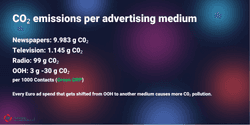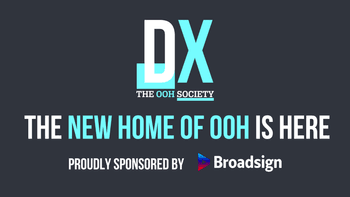For years, scientific evidence has warned us of the many threats of climate change, notably the risk of exceeding the designated global heating limit of 1.5C, a threshold we’re expected to cross within the next ten to fifteen years. As a result, countries worldwide, especially the G7, are taking critical measures and introducing stringent policies to prevent global warming from worsening.
Of course, governing bodies aren’t the only ones demanding action. Consumers are shifting their priorities and have become more interested in their chosen brands’ Environmental, Social and Governance (ESG) efforts. Recent research from BusinessWire found that 85% of consumers have become more eco-conscious over the past few years, and 30% of shoppers globally are willing to pay extra for sustainable products. In turn, brands are becoming more vocal with their commitments to sustainability in manufacturing, business operations, and advertising.
Broadsign recently hosted a Sustainability and OOH panel discussion at our Customer Summit at ISE 2023 in Barcelona, where we invited out-of-home (OOH) experts to share their insights and perspectives on overcoming current challenges and industry initiatives to reach a more sustainable future. Check out the highlights below.
The Big Bad Wolf of Advertising?
With the size and prominence of billboards rendering them an easy target, OOH has historically been viewed negatively in terms of sustainability. Our panellists dove right in, discussing how the industry is challenging these negative stereotypes while also tackling key focus areas head-on, like using more sustainable materials, energy sources, and evaluating current practices to offset footprints with carbon emission reduction plans.
Dr. Kai-Marcus Thäsler, Managing Director at FAW, shared his recent experience in Germany, where activists targeted OOH, pushing policymakers to introduce regulations requiring that digital screens and signage be turned off overnight to save energy as part of the European Union’s energy-saving plan. These movements also impacted parts of Switzerland, with the city of Geneva working to ban billboards on the streets.
“Just eighteen months ago, sustainability wasn’t even part of our conversations with media agencies, advertisers [and policymakers],” said Pedro Fernandez Sanz, Product Marketing Director at Clear Channel Spain. “Now, it’s at the very top of the agenda. We’re [consistently] being asked about what energy we’re using, which is green energy, so it’s very top of mind for media owners.”
Fortunately, the industry’s efforts are moving rapidly, and significant improvements have emerged. In Germany, Thäsler and the team at FAW have taken action to help overturn anti-OOH policies by focusing on the positive aspects of the channel. “Digital-out-of-home in Germany contains both content and advertising,” he says. “That’s the reason why we, in theory, can leave it on. It has [the ability] to provide safety lighting, emergency messaging, and critical community infrastructure.”
Given that OOH is a one-to-many medium, meaning one ad can reach thousands of viewers, adjusting for reach shows that OOH can be a very Co2-efficient medium. Research by FAW showed that when compared to channels like newspapers, TV, and radio, OOH produced the lowest amounts of Co2 pollution per 1000 media consumers.
A key factor in social progress
There are many other reasons why OOH is an ally for societal progress. The medium provides value to the public and is a key infrastructure supplier for cities and municipalities. OOH displays not only bring important services to communities like political or city information, but they also contribute towards the investment of projects like transit shelters, charging stations, city wifi, public toilets, and more.
The future of sustainability in OOH
Today, ESG efforts are a huge topic of conversation between agencies, media owners, tech providers and more – and this is expected to continue as more advancements are made. One way the medium has significantly improved is by using refurbished and recyclable materials for billboards and collateral. Many media owners invest heavily in renewable energy, like switching to LED displays or installing solar panels to power their screens.
“This year, we started the second stage in our objective to neutralize our footprint, which is to neutralize our power consumption. We evaluated how much power we consume, and every month we work towards subsidizing the production of local, green energy. We’re also going to be looking at our plastic consumption,” says Christian Vaglio-Giors, CEO of Neo Advertising. “These are very important initiatives to show the public that we take sustainability very seriously, and that we’re willing to innovate with new solutions to offset all the resources consumed in our business.”
“There’s more demand for adding green elements to OOH,” adds Eric Kip, Managing Director at Global Media & Entertainment NL. “There’s also the question of how we can use refurbished materials, which were not even part of the discussion four or five years ago when we had zero green elements. The changes are being made very rapidly, and our work will need to become bigger, more demanding, and more diverse.”
A primary goal is to educate citizens and policymakers on how modern practices and products are becoming more sustainable and transparent than ever before. When asked if there was a difference between traditional OOH and DOOH regarding sustainability, our panellists agreed that the real distinction lies in the DNA of a company. Each company in the industry, from agencies to publishers to tech providers, is responsible for analyzing its value chain and understanding what daily changes it can make to reduce or neutralize its carbon footprint. While achieving these goals won’t happen overnight, OOH companies need to be proactive and make decisions at the management level to minimize the environmental impact of operations.
OOH media companies also face increasing pressure from advertisers to work towards more sustainable practices. Sustainable products and consumption are important to consumers, and brands are investing more in R&D to meet these demands. Agencies are also getting into action with advances like using sustainable advertising materials across campaigns and certification requirements for OOH suppliers.
The industry is headed towards becoming more transparent about the sustainability goals they’ve achieved, including actively monitoring practices, expanding green OOH options to attract more eco-conscious clients, and promoting trends in sustainable innovations within the space. To ensure they are helping to move the needle when it comes to advocating for a better environment, media owners should continue to prioritize sustainability across all aspects of their business operations.
“We will see sustainability initiatives be a key part of daily business in less than 18 months,” predicts Pedro Fernandez Sanz of Clear Channel Spain. His advice? “Create sustainability reports to structure your operations. As market demand grows, it’s important to stay one to two steps ahead of what’s being asked. The entire ecosystem is shifting, and these discussions are taking place internationally with a heavy focus on DOOH”.
With the industry rapidly evolving and the ongoing commitment to sustainability leading the charge, there’s no doubt that OOH will continue to work towards more positive practices while striving to give back to communities. To learn more about Broadsign’s commitment to sustainability, read a letter from CEO Burr Smith on the steps we’re taking to achieve a better, cleaner future together.








